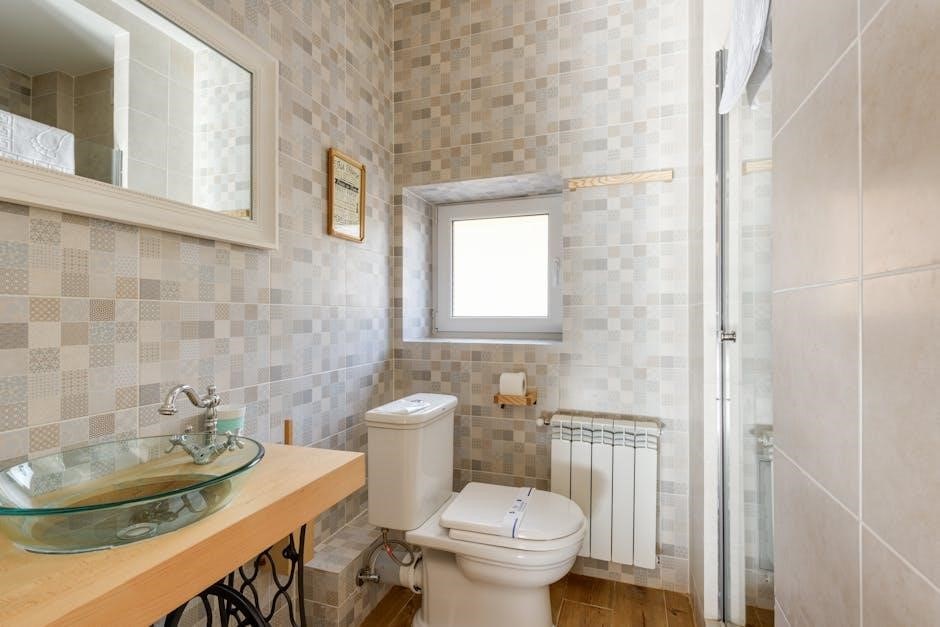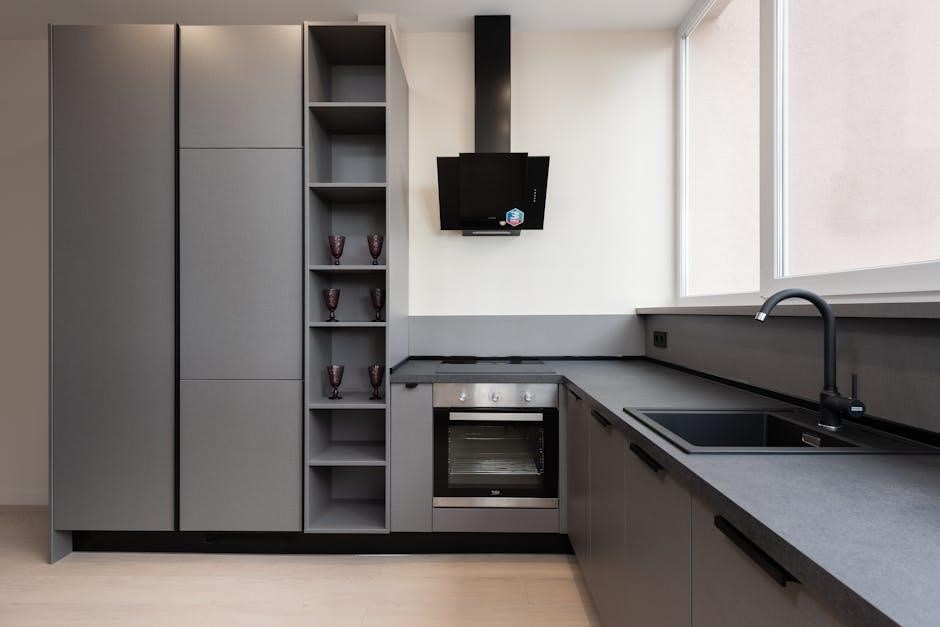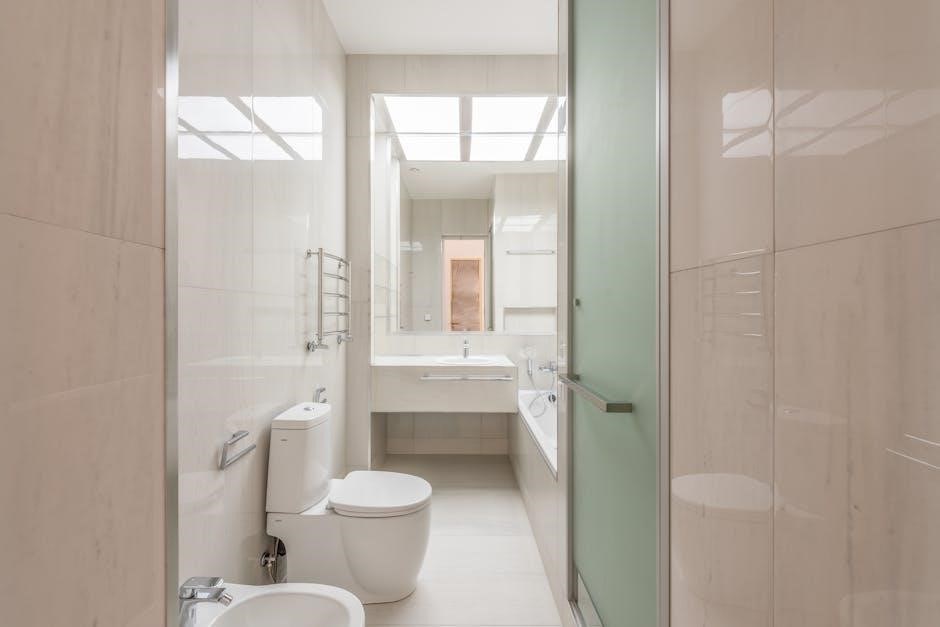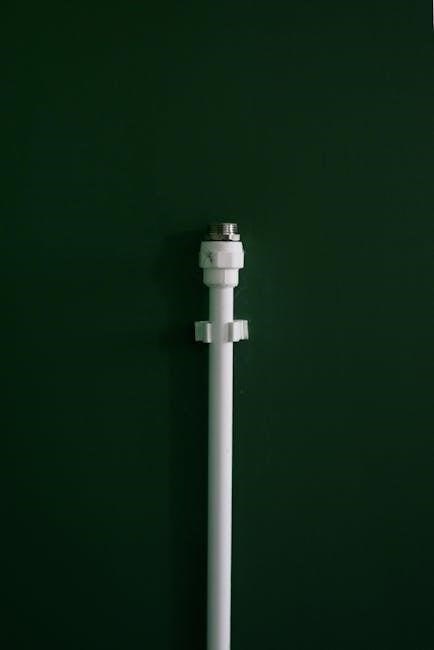A house plumbing system diagram PDF provides a visual representation of a home’s water flow through pipes and fixtures. These diagrams are invaluable for homeowners and plumbers alike‚ offering a clear understanding of the plumbing system’s structure.
Understanding House Plumbing Systems

Understanding house plumbing systems is crucial for homeowners to maintain their property and address potential issues effectively. A plumbing system encompasses the network of pipes‚ fixtures‚ and appliances that supply water and remove wastewater from a building. These systems typically include a water supply system‚ a drainage system‚ and a venting system.
The water supply system brings potable water into the house‚ while the drainage system removes wastewater. The vent system regulates air pressure in the drain pipes to ensure proper flow and prevent sewer gases from entering the home. Familiarizing oneself with these components is essential for basic troubleshooting and maintenance.

Plumbing systems also incorporate various fixtures such as sinks‚ toilets‚ showers‚ and appliances like dishwashers and washing machines. Each fixture requires a proper connection to both the water supply and drainage systems. Understanding how these elements interact is key to preventing leaks‚ clogs‚ and other common plumbing problems.
Importance of Plumbing Diagrams
Plumbing diagrams are essential tools for anyone involved in the design‚ installation‚ or maintenance of plumbing systems. These diagrams provide a visual representation of the entire system‚ illustrating the layout of pipes‚ fixtures‚ and other components. They are incredibly helpful for understanding the flow of water and waste within a building.
For homeowners‚ plumbing diagrams can be invaluable for troubleshooting plumbing issues. By referencing a diagram‚ they can quickly identify the location of pipes and fixtures‚ making it easier to diagnose problems and determine the best course of action. This can save time and money by preventing unnecessary repairs or calling a plumber for simple fixes.
Plumbers also rely heavily on plumbing diagrams to ensure accurate installations and repairs. A detailed diagram helps them understand the existing system‚ identify potential problems‚ and plan their work efficiently. Moreover‚ plumbing diagrams are necessary for complying with building codes and regulations‚ ensuring that the plumbing system is safe and functional.

Elements of a House Plumbing System
A typical house plumbing system comprises several key elements working together. These include the water supply‚ drainage‚ vent systems‚ and fixtures. Each plays a crucial role in delivering water and removing waste effectively.
Water Supply System
The water supply system is the backbone of any house’s plumbing‚ responsible for delivering potable water throughout the building. It typically begins with a connection to the municipal water main or a private well‚ ensuring a consistent source of water for daily needs. This system consists of a network of pipes‚ usually made of copper‚ PEX‚ or CPVC‚ strategically routed to supply fixtures and appliances.
Key components include shut-off valves‚ which allow for isolating sections of the plumbing for maintenance or repairs‚ preventing water wastage and damage. Pressure regulators maintain optimal water pressure‚ preventing damage to pipes and fixtures from excessive force. A water meter measures water consumption for billing purposes.
The water supply system branches into hot and cold water lines‚ with the hot water line connected to a water heater‚ providing heated water for showers‚ sinks‚ and appliances like dishwashers and washing machines. Proper insulation of hot water pipes minimizes heat loss‚ improving energy efficiency and reducing utility costs‚ ensuring a reliable and efficient water distribution network.
Drainage System
The drainage system is an essential component of a house’s plumbing‚ designed to remove wastewater safely and efficiently. Unlike the pressurized water supply system‚ the drainage system relies on gravity to carry waste away from fixtures and appliances. It consists of a network of pipes that slope downwards‚ ensuring wastewater flows towards the main sewer line or septic tank.
Each plumbing fixture‚ such as sinks‚ toilets‚ and showers‚ is connected to the drainage system through a trap‚ a U-shaped pipe that holds water‚ preventing sewer gases from entering the house. These gases can be harmful and unpleasant‚ making traps a critical safety feature.
The drainage system includes vents that allow air to enter the pipes‚ preventing vacuums from forming and ensuring proper flow. These vents extend upwards and exit through the roof‚ maintaining atmospheric pressure within the system. The main drain line carries all wastewater to the sewer or septic system‚ where it is treated and disposed of‚ keeping the home sanitary.
Vent System
The vent system is a crucial part of a house’s plumbing‚ working in tandem with the drainage system to ensure proper wastewater removal. Its primary function is to regulate air pressure within the drainage pipes‚ preventing vacuums from forming and ensuring smooth flow. Without a properly functioning vent system‚ wastewater would drain slowly or not at all.
Vents allow air to enter the drainage pipes‚ equalizing pressure and preventing suction that can siphon water from fixture traps. These traps are essential for blocking sewer gases from entering the home‚ and their effectiveness relies on the vent system.
The vent system consists of a network of pipes that extend upwards from the drainage lines and terminate above the roof. This allows air to freely enter and exit the system‚ maintaining atmospheric pressure. Proper venting is vital for preventing unpleasant odors and ensuring the efficient operation of the entire plumbing system‚ contributing to a healthier living environment.
Fixtures and Appliances
Fixtures and appliances represent the visible and functional endpoints of a home’s plumbing system; These components are where water is used and wastewater is generated‚ connecting directly to both the water supply and drainage systems. Common fixtures include sinks‚ toilets‚ showers‚ and bathtubs‚ each designed for specific purposes and requiring precise plumbing connections.
Appliances such as dishwashers‚ washing machines‚ and water heaters also rely on the plumbing system for their operation. They require connections to both hot and cold water lines‚ as well as drainage for wastewater. The placement and installation of these fixtures and appliances are critical considerations in plumbing design.
Proper installation ensures efficient water usage‚ prevents leaks‚ and facilitates easy maintenance. Plumbing diagrams are essential for accurately representing the location and connections of these fixtures and appliances‚ aiding in both initial installation and future repairs. Understanding the specific plumbing needs of each fixture and appliance is vital for a well-functioning and reliable home plumbing system.

Creating a Plumbing Diagram
Creating a plumbing diagram involves understanding standard symbols and utilizing tools for accurate representation. This process helps visualize the system’s layout‚ aiding in installation‚ maintenance‚ and troubleshooting efforts effectively.
Plumbing Plan Symbols
Plumbing plan symbols are essential for accurately representing various components within a plumbing system on a diagram. These symbols provide a standardized visual language‚ allowing plumbers‚ contractors‚ and homeowners to easily understand the layout and function of the system. Common symbols include those for pipes‚ valves‚ fixtures (such as sinks‚ toilets‚ and showers)‚ and fittings (like elbows‚ tees‚ and couplings). Each symbol represents a specific element‚ ensuring clarity and consistency across different plumbing plans.
Understanding these symbols is crucial for interpreting plumbing diagrams and for creating new ones. Correctly using symbols ensures that the diagram accurately reflects the actual plumbing system‚ aiding in installation‚ repairs‚ and maintenance. Resources are available online and in plumbing guides that illustrate and explain the meanings of various symbols. These resources help users become familiar with the standard conventions‚ promoting effective communication and reducing errors during plumbing projects. Moreover‚ utilizing the correct plumbing symbols is the foundation for effectively troubleshooting any issues.
Tools for Creating Diagrams (EdrawMax‚ ArcSite)
Creating plumbing diagrams has been greatly simplified with the advent of user-friendly software like EdrawMax and ArcSite. These tools offer a range of features specifically designed to aid in the creation of accurate and detailed plumbing plans. EdrawMax is a versatile diagramming tool that provides a comprehensive library of plumbing symbols‚ drag-and-drop functionality‚ and customizable templates. This allows users to easily create professional-looking diagrams‚ even without extensive technical expertise.
ArcSite‚ on the other hand‚ is a field-based drawing tool that enables users to create diagrams directly on-site using mobile devices. It offers features like accurate measurement tools and integration with CAD software‚ making it ideal for both new installations and renovations. Both EdrawMax and ArcSite streamline the diagramming process‚ making it more efficient and accessible. By utilizing these tools‚ plumbers‚ contractors‚ and homeowners can create clear and accurate plumbing diagrams that facilitate better communication and project execution.

Types of Plumbing Diagrams

Plumbing diagrams come in various forms‚ each serving a specific purpose. These include residential plumbing layout plans‚ detailing the entire system‚ and drainage plumbing diagrams‚ focusing on waste removal and vent systems.
Residential Plumbing Layout Plans
Residential plumbing layout plans provide a comprehensive overview of the entire plumbing system within a house. These plans typically illustrate the location of all water supply lines‚ drain lines‚ and vent stacks. They also show the placement of plumbing fixtures such as sinks‚ toilets‚ showers‚ and water heaters. These layouts are essential for both new construction and remodeling projects‚ ensuring that the plumbing system is installed correctly and efficiently.
A well-designed residential plumbing layout plan considers factors such as water pressure‚ pipe sizing‚ and drainage requirements. It also takes into account local plumbing codes and regulations. These plans can be used by plumbers to accurately estimate the cost of a project and to avoid costly mistakes during installation. Homeowners can also benefit from these plans by gaining a better understanding of their home’s plumbing system and identifying potential problems before they escalate.
Residential plumbing layout plans often include detailed diagrams and specifications‚ making them a valuable resource for anyone involved in the plumbing process.
Drainage Plumbing Diagram
A drainage plumbing diagram specifically focuses on the wastewater disposal system within a building. Unlike a general plumbing plan‚ this diagram highlights the network of pipes responsible for carrying waste away from fixtures and appliances. It meticulously illustrates the connections between sinks‚ toilets‚ showers‚ and the main sewer line or septic system. The diagram also shows the placement of traps‚ which prevent sewer gases from entering the building‚ and vents‚ which allow air to circulate and maintain proper drainage flow.
These diagrams are crucial for identifying potential blockages‚ leaks‚ or other drainage issues. Plumbers use them to troubleshoot problems and plan repairs or modifications to the drainage system. A well-constructed drainage plumbing diagram includes pipe sizes‚ slopes‚ and material specifications‚ ensuring efficient and code-compliant wastewater removal. It’s an indispensable tool for maintaining a healthy and functional plumbing system.

Troubleshooting with Plumbing Diagrams
Plumbing diagrams are essential tools for troubleshooting plumbing issues‚ allowing for efficient identification of potential problems. They aid in visualizing the system’s layout‚ making repairs easier and more targeted.
Identifying Potential Issues
A plumbing diagram serves as a roadmap for identifying potential issues within a home’s plumbing system. By visually tracing the network of pipes‚ homeowners and plumbers can pinpoint the source of leaks‚ clogs‚ or pressure problems. Diagrams illustrate the connections between fixtures‚ drains‚ and the main water supply‚ making it easier to isolate problem areas. This is particularly useful in older homes where the plumbing layout may be complex or undocumented.
With a clear diagram‚ one can quickly assess if the hot and cold water lines are correctly connected or if the drainage system has proper venting. Recognizing deviations from the standard layout can highlight potential code violations or improper installations that may be contributing to plumbing malfunctions. Moreover‚ diagrams allow for proactive maintenance by identifying areas prone to corrosion or wear‚ preventing future emergencies and costly repairs. Regular inspection using a plumbing diagram can thus extend the lifespan of the entire system.
Using Diagrams for Repairs
Plumbing diagrams are essential tools when undertaking repairs‚ providing a clear visual guide to the system’s layout. When facing a plumbing issue‚ consulting the diagram helps in understanding how components connect‚ enabling targeted repairs. Instead of blindly guessing‚ the diagram shows the exact pipe routes and valve locations‚ reducing unnecessary exploratory work.
For instance‚ when replacing a section of pipe‚ the diagram indicates the pipe’s length‚ diameter‚ and the fittings required‚ ensuring the correct materials are purchased. It also reveals the presence of shut-off valves‚ preventing water wastage and potential flooding during repairs. Moreover‚ the diagram aids in reassembling the system correctly‚ especially in complex setups. By following the diagram‚ one can confidently tackle repairs‚ minimizing errors and ensuring the plumbing system functions efficiently after the work is completed. This ultimately saves time‚ money‚ and prevents further damage.

Plumbing Codes and Regulations
Adhering to plumbing codes and regulations is crucial for ensuring safety‚ efficiency‚ and compliance in any plumbing project. These codes‚ often based on international standards‚ dictate the acceptable materials‚ installation methods‚ and system designs for plumbing systems. Compliance with these regulations ensures that the plumbing system functions safely and effectively‚ preventing potential health hazards like water contamination or sewer gas leaks.

Local jurisdictions typically enforce their own versions of these codes‚ which may vary based on climate‚ water quality‚ and other regional factors. Plumbing diagrams play a vital role in demonstrating code compliance during inspections and permitting processes. Accurate diagrams showcase the system’s layout‚ pipe sizes‚ venting‚ and other critical details‚ providing inspectors with the necessary information to verify adherence to regulations. Failing to meet these standards can result in costly rework‚ delays‚ and even legal penalties. Therefore‚ understanding and following plumbing codes is essential for any plumbing endeavor.